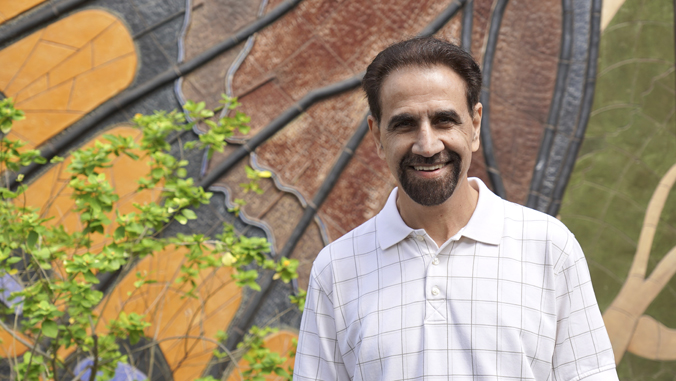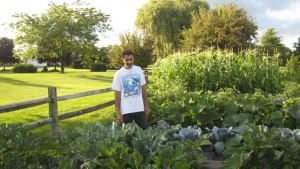
(UH News asked CTAHR Dean Parwinder Grewal questions about his vision for the college. Some of his answers were shortened for length.)
The new University of Hawaiʻi at Mānoa College of Tropical Agriculture and Human Resources (CTAHR) Dean Parwinder Grewal chatted with UH News about his vision for the future of CTAHR and its role in Hawaiʻi.
What made you interested in the CTAHR dean position?

The biggest thing that excited me about Hawaiʻi and CTAHR is mālama ʻāina, the Hawaiian passion for taking care of the land and the environment that sustains us. All my background starting from my childhood to professional life till now has focused on sustainable agricultural practices and programs. UH has a significant commitment to sustainability and a strong aspiration to becoming a Native Hawaiian Place of Learning. My background, experience and aspirations blend in nicely with the university and college missions.
What is your vision for CTAHR?
My vision is to build CTAHR as a model land-grant college that discovers solutions and provides statewide leadership in building food, energy and economic security through increased local self-sufficiency. The focus of our work from my perspective would be both on high impact research in our labs and on experimental farms and on collaborating with community leaders, farmers, families, entrepreneurs, state agencies, and non-profits for building and implementing innovative and sustainable solutions to Hawaiʻi’s food, energy, and environmental challenges.
What are going to be your top three priorities in the first year?
First, I want to meet with every person in CTAHR individually within my first three months. I want to learn what people are excited about, what their goals are and what challenges they are facing. This asset mapping will provide a better picture of CTAHR’s capacity and needs. It will also capture ideas for new programs, initiatives and facilities.
Second, I would like to meet with key stakeholders in Hawaiʻi engaged in food, energy, and ag-related sectors to learn about their work and challenges and to determine how CTAHR can become a more effective partner in securing the future of Hawaii through increased food, energy and economic security.
Third, I would like to begin fostering an environment for collaborative innovation both within the college and the university and across the state. I would like to encourage, empower and facilitate engagement of faculty, students, and staff with families, community leaders, farmers, restaurants, entrepreneurs, K–12 schools, community colleges, and legislators to start building collaborative innovations to strengthen Hawaiian agriculture and develop new value-added products locally, sustainably, and cost-effectively.
As you educated yourself about Hawaiʻi and CTAHR, what did you learn?
I found that CTAHR faculty, staff and students are very excited about their work. They care deeply about the land grant mission of the college. They care about Hawaiʻi and Hawaiian families and farmers. I also saw that CTAHR faculty have a lot of expertise in many different areas. I strongly believe CTAHR’s expertise and passion can be channelized for creating a real impact on bolstering Hawaiʻi’s food, energy, and economic security.
Where did you grow up, and what inspired you towards agriculture?
I grew up in India in a farming family, with a very small farm where we grew crops ourselves for subsistence. In 10th grade, I was beginning to see how agriculture was changing at that time. It was the first time we heard about chemical fertilizers, until then our agriculture was all organic and we applied animal manure to our farm with our hands. I chose to go to the Punjab Agricultural University to learn more about agriculture. From second year, when we started going deep into the science of agriculture including how to grow crops for high yields and how to identify and manage insect pests and diseases, I realized how passionate I was about what I was learning.
One story I often tell is about a dream I had when I was in college. In 1978, it was all over in the news that a decommissioned NASA space station, SkyLab, will fall on Earth, but scientists didn’t know exactly where it would fall. As NASA was hoping that it falls in the Indian Ocean, people were worried about the impending disaster posed by the 77-ton loose cannon. After I heard the news, that night, I had a dream in which I was saying, “let the SkyLab fall anywhere else, but not on my university.” Ironically, I wasn’t worried about my family or home in the dream, but I was worried about my university. I was learning so much about the science of agriculture and I became so attached to the university.
Is there something that you want to say that you didn’t have a chance to say?
Basically, I would like to reiterate my passion for securing the future of Hawaiʻi through increased local self-sufficiency in food and energy and for building new value-added products right here in Hawaiʻi. In a way we will champion the Made in Hawaiʻi label. My leadership style is more visionary and inspirational, and I believe in collaborative innovation. We will connect CTAHR’s expertise with community leaders, farmers, entrepreneurs, non-profits, local government officials, and the legislature to foster a local self-sufficiency movement to build increased food, energy, and economic security for Hawaiʻi.
What is a nematode and what’s your fascination with it? (Grewal is an expert in nematology)
A nematode is a roundworm. These are microscopic organisms and there are many different types. Many nematode species are beneficial but a few can be detrimental to our crops and livestock. Nematodes live in soil, water and in animals. I have been fascinated with the beneficial nematodes particularly those that are now being used in biocontrol of insects. The ones CTAHR faculty mostly work on are the plant-parasitic ones that negatively impact our agricultural and horticultural plants.

